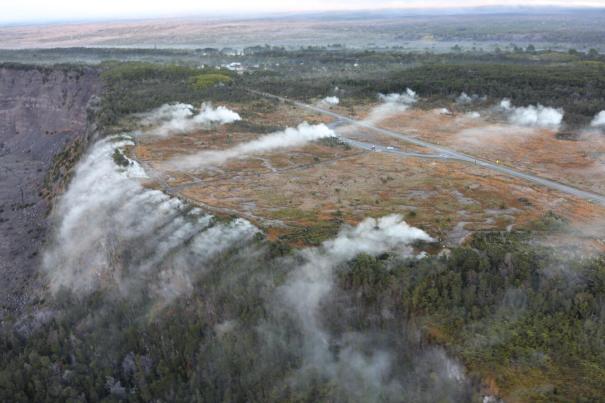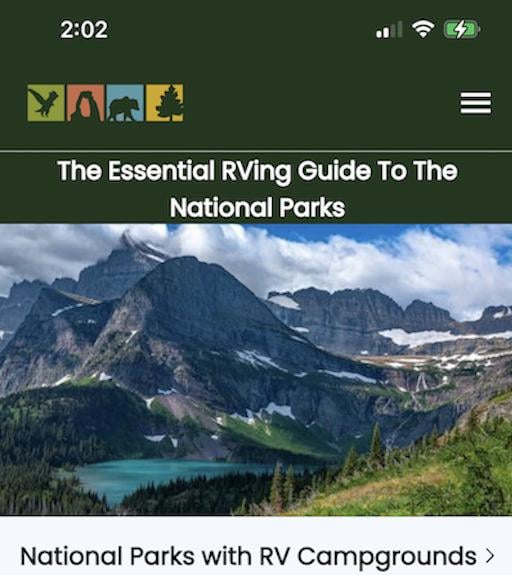Editor's note: Volcano Watch is a weekly article and activity update written by U.S. Geological Survey Hawaiian Volcano Observatory scientists and affiliates. Today's article was written by Research Corporation of the University of Hawai‘i geologist Katie Mulliken with HVO volunteer and naturalist Bobby Camara. This article was translated from English into ʻŌlelo Hawaiʻi by Nakamakanikolonahe Obrero.
February is Mahina ʻŌlelo Hawaiʻi, Hawaiian Language Month, and an opportunity to appreciate the value that the Native Hawaiian language has provided to volcanology, especially here in Hawaiʻi nei.
ʻO Pepeluali ka Mahina ʻŌlelo Hawaiʻi, a he manawa kūpono ia e mahalo aku ai ka waiwai na ka ʻŌlelo Hawaiʻi i hoʻolako i ke kālaipele, ʻoi loa aku ma Hawaiʻi nei.
He ʻumikūmālua huapala ma ka pīʻāpā Hawaiʻi, me nā maka puana ʻelua e hōʻike ai i ka puana pololei. ʻO ka ʻokina, he kohu koma luna i huli ʻokoʻa lā me ka hoʻohana ʻia ʻana ma ke ʻano he koneka, a ʻo ke kahakō, he kohu laina pololei i luna o nā woela e hōʻike ana ka puana woela lōʻihi. ʻO ka ʻŌlelo Hawaiʻi a me ka ʻŌlelo Pelekānia pū nā ʻōlelo kūhelu o ka mokuʻāina o Hawaiʻi.
Native Hawaiians were the first observers of volcanic activity in Hawaiʻi and used words for geologic features that science communities continue to apply today. Volcanologists around the world use pāhoehoe, ʻaʻā, and kīpuka, for example. Pāhoehoe and ʻaʻā are the two main types of basaltic lava flows. Pāhoehoe has a smooth, sometimes ropy texture whereas ʻaʻā is rough and broken. Kīpuka color the lava flow landscape like patchwork. They are pockets of vegetation surrounded by younger lava flows, illustrating one definition of kīpuka as “a variation or change in form.”
ʻO nā kanaka ʻōiwi kai kiaʻi mua loa o ka lua pele ʻā, a hoʻohana ʻia akula nā huaʻōlelo no nā hiʻohiʻona hulihonua na ke kaiaulu akeakamai e hoʻopili nei i kēia mau lā. Hoʻohana akula nā kanaka kālaipele a puni ka honua i ia mau huaʻōlelo i laʻa me ka ʻaʻā, ka pāhoehoe, a me ke kīpuka. ʻO ka pāhoehoe a me ka ʻaʻā nā ʻano ʻā pele ʻalā nui ʻelua. He hiʻonapāʻili laumania me kekahi ʻano kaula lā ka pāhoehoe, no ka mea kākala a me nāpelepele ka ʻaʻā. Palapalaulu ke kīpuka i ka hiʻonaina ʻā pele me he pāhono lā. He mau ʻāpana ʻāina nāhelehele ia e kaʻapuni ʻia e ka ʻā pele hou loa, e hōʻike ana kekahi manaʻo o ke kīpuka ma ke ʻano he loli i kona kino.
Numerous newspapers of the 1800s written by Native speakers, and published in ʻŌlelo Hawaiʻi, provide us valuable insight to eruptions and their effects, while ʻŌlelo Hawaiʻi place names help us understand landscapes and their use. Keanakākoʻi, for example, is a small crater near the summit caldera of Kīlauea. Its name means “the cave in which azdes were made,” providing us with an understanding of the place (a crater) and how the location was used in the past (adze source).
Manomano nā nūpepa o nā makahiki 1800 i kākau ʻia e nā mānaleo, a hoʻopuka ʻia hoʻi ma ka ʻŌlelo Hawaiʻi, e hoʻolako ana iā kākou i ka ʻike waiwai no ka huaʻi ʻana o ka lua pele a me kona mau hopena, ʻoiai hoʻomaopopo pū mai nā inoa wahi i nā hiʻohiʻona ʻāina a me kona mau waiwai. I laʻana, he lua liʻiliʻi ʻo Keanakākoʻi i ka nuʻu o Kīlauea. ʻO ka manaʻo o kona inoa, ʻo ia ʻo ke ana nona ke koʻi, a he hōʻike kēia i ka hoʻomaopopo ʻana mai i ia wahi a me ke ʻano ona i hoʻohana ʻia ma ka wā i hala.
Native Hawaiian oral traditions also inform volcanologists of the range of behaviors at Hawaiʻi’s active volcanoes. For example, when a water lake appeared at the bottom of Halemaʻumaʻu following the 2018 caldera collapse, Hawaiian chants provided clues that surface water had been found at the summit in earlier times. Likewise, the saga of Pele and Hiʻiaka is thought to record extensive lava flows, as well as an earlier collapse of Kīlauea summit caldera, in about the year 1500.
Hoʻonaʻauao pū mai nā moʻolelo kuʻuna Hawaiʻi i nā kanaka kālaipele no ka lawena laulā ma nā luapele o Hawaiʻi. I laʻana, i ka wā i huaʻi ai ka loko wai i ka piko o Halemaʻumaʻu ma hope o ka hāneʻe ʻana o Kaluapele ma 2018, aia ma nā oli Hawaiʻi he mau ʻāhuoi no ka huaʻi ʻana o ka wai i ka lua ma ka wā ma mua. E like pū me ka moʻolelo o Pele a me Hiʻiaka e hoʻopaʻa ana i ka nui ʻā pele, me kekahi hāneʻe ʻana o ka nuʻu o Kīlauea ma kahi o ka makahiki 1500.
Native Hawaiians today continue to call the elemental force creating the ʻāina (land) Pelehonuamea (Pele of the red earth), while molten lava is pele (no longer used with English additions such as “Madame, Goddess, or Deity”). ʻŌlelo noʻeau (Hawaiian sayings and proverbs compiled and interpreted by Mary Kawena Pukui) pertaining to Pelehonuamea describe her relationship with landscapes and people living on them, particularly in the District of Puna. “Ka wahine ʻai lāʻau o Puna” translates to the “tree-eating woman of Puna.” “Pōʻele ka ʻāina o Puna,” tells us that “The land of Puna is blackened [by lava flows].” These sayings convey a sense of geologic history of destructive lava flows from Kīlauea in Puna.
Mau nō nā kanaka maoli e kapa aku ana i ke akua nāna ka hānau ʻāina ʻo Pelehonuamea, ʻo Pele o ka honua mea hoʻi, a ʻo ka pele hoʻoheheʻe ʻia ka pele, ʻoiai ʻaʻole hoʻohana i nā inoa kapakapa e like me Madame, Goddess, a i ʻole ʻo Deity. Wehewehe nā ʻŌlelo noʻeau, ʻo ia nā ʻōlelo akamai na Mary Kawena Pukui i hōʻuluʻulu a unuhi, no Pelehonuamea i kona pilina me nā hiʻohiʻona ʻāina a me ka poʻe e noho ana ma laila, keu hoʻi ma ka moku ʻo Puna. Unuhi ʻia ʻo Ka wahine ʻai lāʻau o Puna i ka manaʻo no ka wahine o Puna nāna e pau ana ka ululāʻau i ka ʻai ʻia.” Hōʻike ʻia ka manaʻo ʻo Pōʻele ka ʻāina o Puna i ka ʻāina o Puna i pōʻele ʻia e ka ʻā pele. Hōʻike kēia mau ʻōlelo noʻeau i ka mōʻaukala hulihonua o nā ʻā pele lauahi mai Kīlauea i Puna.
Over the years, spellings of ʻŌlelo Hawaiʻi words and place names have evolved, to better reflect their pronunciation, meaning, or grammar. For example, the Hawaii Board on Geographic Names provides guidance to the U.S. Board on Geographic Names (USBGN), which standardizes the spellings names of places, features, and areas within the United States. They recently corrected the spelling of lava shield features on the Southwest Rift Zone and East Rift Zone of Kīlauea. Maunaiki and Maunaulu, both of which used to be two words (Mauna Iki and Mauna Ulu), are now one to better align with ʻŌlelo Hawaiʻi rules, grammar, and usage.
Ma ka holo ʻana o nā makahiki, liliuewe maila ka pela ʻana o nā huaʻōlelo Hawaiʻi a me nā inoa ʻāina, i mea e hōʻike kūpono ai kona puana, kona manaʻo, a i ʻole kona ʻōlelo. I laʻana, alakaʻi mai ka ʻAha Kūkā Hawaiʻi i ka ʻAha Kūkā ʻAmelika hui pū ʻia, ʻo USBGN hoʻi, ma nā inoa hulihonua, e hoʻopaʻa kūmau ana ka pela inoa ʻana o nā ʻāina, nā hiʻohiʻona, a me nā wahi i loko o ʻAmelika hui pū ʻia. ʻAkahi nō lākou a hoʻopololei i ka pela ʻana o nā hiʻohiʻona kuahene pele ma ke kāʻei māwae komohana hema a me ke kāʻei māwae hikina o Kīlauea. Hoʻokuʻi ʻia ʻo Maunaiki a me Maunaulu, ʻoiai he ʻelua huaʻōlelo nā inoa ʻelua ma mua ʻo ia ʻo Mauna Iki a me Mauna Ulu, i mea e hahai pololei ai i nā lula, ka ʻōlelo a me kona mau ʻano i hoʻohana ʻia ma ka ʻōlelo Hawaiʻi.
The names of some locations have also changed over time. Using details found on archival maps of the early 19th century, the name of Kīlauea caldera, the site of frequent eruptions over the past 200 years, was recently updated in the USBGN database to be Kaluapele, meaning “the pit of Pele.” The seamount formerly named Lōʻihi (because of its length) was updated based on Native Hawaiian cultural knowledge, including chants, to Kamaʻehuakanaloa—“the ruddy, reddish child of Kanaloa,” the elemental force whose kuleana (responsibility) includes the ocean.
Hoʻololi pū nā inoa o kekahi o kēia mau ʻāina ma ka holo ʻana o ka wā. Ma ka hoʻohana ʻana i nā lāliʻi i hoʻokumu ʻia ma nā palapala ʻāina kahiko o ke kenekulia ʻumikūmāiwa hiki mua, hoʻololi ʻia ka inoa o ka lua ʻo Kīlauea i Kaluapele, ʻo ia hoʻi kahi e huaʻi pinepine ana ma nā makahiki he 200 i hala aku nei, ma ka polokalamu hōkeo ʻikepili USBGN me ka manaʻo o ka lua a Pele. Ua hoʻololi ka mauna kai i kapa inoa mua ʻia ʻo Lōʻihi, no kona lōʻihi hoʻi, ma muli o ka ʻike kuʻuna ʻōiwi e like me nā oli, i ka inoa ʻo Kamaʻehuakanaloa - ʻo ia ke kama ʻehu a Kanaloa, ʻo ke akua hoʻi nona ke kuleana o ka moana.
The USGS Hawaiian Volcano Observatory looks forward to future opportunities to incorporate ʻŌlelo Hawaiʻi vocabulary, and deeply appreciates valuable observations of volcanic activity made by Native Hawaiians.
Hoihoi Ka Hale Kilo Lua Pele Hawaiʻi USGS i nā wā kūpono mai kēia mua aku e hoʻokomo i ka huaʻōlelo Hawaiʻi, a mahalo maoli ʻia nā kilo waiwai o nā ʻīnana ʻā pele i waiho ʻia e nā kanaka maoli.




Add comment